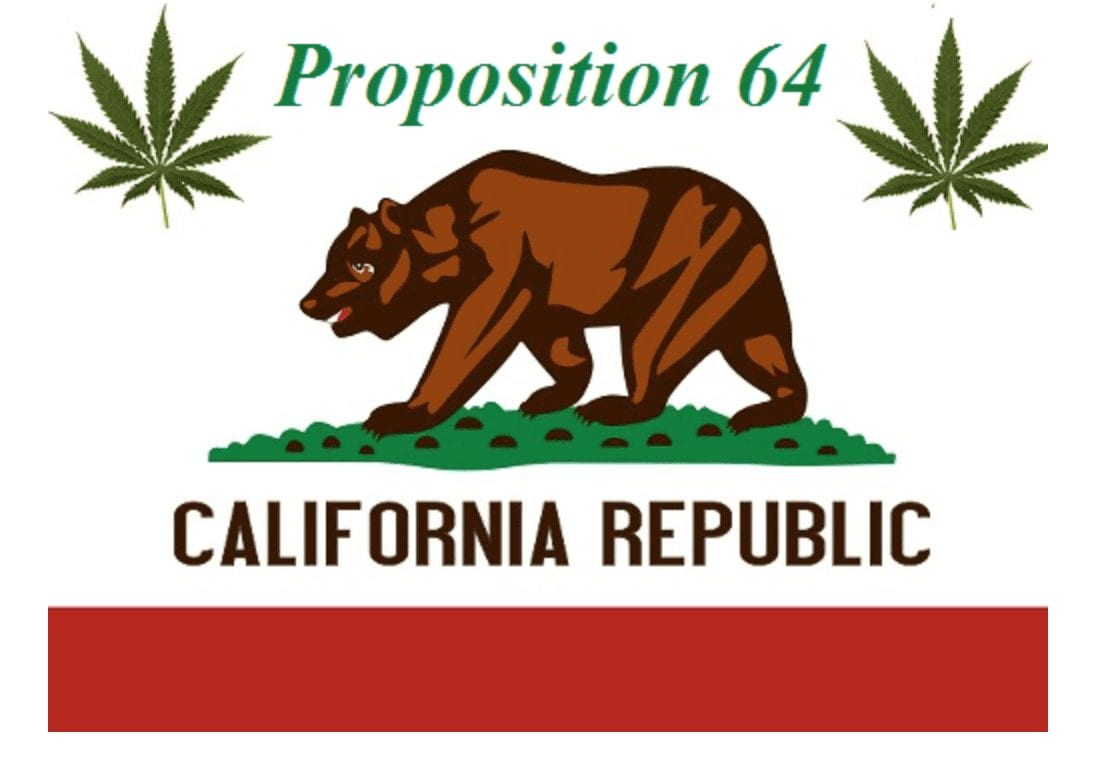
Californians have another opportunity to legalize marijuana on November 8, 2016 with Proposition 64: The California Marijuana Legalization Initiative. If passed, adults over age 21 can purchase, possess and propagate plants for personal use.
Recreational marijuana would be available in licensed stores for taxable sale and consumption. The proposition includes specific restrictions and safeguards to protect children, employers, drivers, consumers and growers.
Voting “no” keeps recreational marijuana use, sale and cultivation illegal, but wouldn’t change existing medical marijuana laws under the Compassionate Use Act (Prop 215).
The Official Voter Information Guide for the California General Election explains the proposition and provides arguments both for and against it:
Prop 64 would make it LEGAL to:
– Recreationally smoke or ingest cannabis in private homes and licensed businesses
– Grow up to six plants in a locked, private home
– Possess 28.5 grams of flower and eight grams of concentrate
– Require commercial growers to be licensed and taxed at $9.75 per ounce of buds and $2.75 per ounce of leaf, excluding medical marijuana.
– Impose a 15 percent sales tax
– Regulate packaging, labeling, advertising, and marketing
– Prevent big corporations from getting a license for five years, to avoid an “unlawful monopoly power”
– Re-sentence certain people convicted of marijuana violations
– Form environmental regulations for water and pesticide use
– Ban recreational marijuana businesses in jurisdictions by localities, with or without voter approval
– Restrict employees from consuming marijuana on and/or off the clock
From the Voter Guide: “California Medical Association supports Prop. 64 because it incorporates best practices from states that already legalized adult marijuana use, and adheres closely to the recommendations of California’s Blue Ribbon Commission on Marijuana Policy, which included law enforcement and public health experts.”
What about the children?!
Prop 64 would uphold these ILLEGAL actions:
– Driving while impaired from cannabis
– Consuming marijuana in public and anywhere tobacco is outlawed
– Giving marijuana to minors
– Advertising to children
– Operating pot shops within 600 feet of schools or kid-friendly places
– Possessing any marijuana at a school, day care center, or youth center
Who’s Buying, Who’s selling?
Businesses would need to get state and possibly local licenses. The tax revenue has specific allocations, first going directly to a new California Marijuana Tax Fund.
Revenue would offset the initial administration of Prop 64. Then, it would be divided between drug research, treatment and enforcement. Specifics are laid out in the “Initiative Text (#15-0103)” from California Secretary of State as accessed on September 20, 2016:
– $2 million per year to the UC San Diego Center for Medical Cannabis Research to study risks and benefits of medical marijuana.
– $10 million per year for 11 years for public California universities to research and evaluate the effects of the measure. Researchers would make policy-change recommendations to the state’s legislature and Governor.
– $3 million annually for five years to the Department of the California Highway Patrol to create and adopt methods to detect marijuana impaired driving.
– $10 million, increasing each year by $10 million until settling at $50 million in 2022, towards grants for job placement assistance and substance use disorder treatment.
– Remaining revenue would be dispersed as follows: 60 percent to youth programs (including drug education, prevention and treatment); 20 percent for environmental protection and restoration efforts related to marijuana cultivation; 20 percent for programs to reduce marijuana impaired driving and a grant program to promote healthy and safe cannabis use.
Seriously, What About the Children?!?!
Opposing arguments center around safety, children’s exposure to ads, small farmers losing income and increased risk of traffic wrecks.
The Federal Communications Commission (FCC) enforces strict prohibitions on smoking ads, tobacco or otherwise, and this wouldn’t change. Broadcasters want to protect their licenses and are reluctant to run marijuana ads because, after all, pot is still federally illegal. Adam Stites, of Mirth Provisions, created an ad for a cannabis drink called Legal Soda, which is sold only online and uses adults-only filters. “The problem with TV is, I don’t think that’s my audience,” Stites said. “I don’t think that’s an efficient ad spend.”
Farmer Green
Small farmers may see lost revenue because prices in the legal market will likely fall. More legal businesses would be licensed, increasing supply, according to the Voter Guide. Corporations like Monsanto stand to get a piece of the pot pie after the five-year grace period ends. Economies which rely heavily on marijuana exports like Humboldt, Mendocino and Trinity counties could be hit hardest, reducing local government tax revenue, notes the Legislative Analyst’s Office of California.
Others argue that local government tax revenues already suffer under the current black market system because illegal sales don’t contribute to public programs.
AAA Released a Study…
The AAA Foundation for Traffic Safety released a study in May 2016 which found the percentage of vehicular fatalities where drivers had THC in their system doubled in Washington from 8 percent to 17 percent by 2014. However, the study also found that most drivers with THC in their system had alcohol or other drugs too. Drivers with traces of THC weren’t necessarily impaired while driving or at fault in the crashes.
A 2015 study by the National Highway Traffic Safety Administration found no big crash association to people driving with marijuana in their systems. Alcohol is still the biggest drug problem related to traffic fatalities, confirmed J.T. Griffin, chief government affairs officer for Mothers Against Drunk Driving (MADD).
How Can I Hemp You?
This initiative also covers hemp: the super-hero plant that can feed, clothe, shelter and fuel without psychoactive effects. Hemp is distinguished from marijuana based on THC levels and would be regulated separately, as written in Section 3 (aa) of Prop 64.
President Obama legalized industrial hemp cultivation, with restrictions, under Section 7606 of the 2014 Farm Bill. While the bill empowers states to decide, it also limits cultivation. Only universities and state departments of agriculture can grow industrial hemp and only if the plants will be used exclusively for agricultural pilot programs or other research purposes.
To weed or not to weed?
With so many factors at play, it’s important to do the research and know the pros and cons. To weed or not to weed this November, whatever your decision, make sure to cast your vote!
Written by Shannon Perkins



Leave a Reply